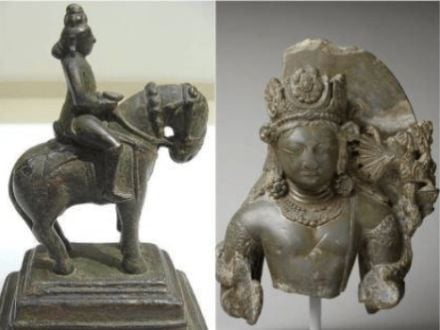
The Metropolitan Museum of Art (Met) in New York, which has faced intense criticism and legal scrutiny over some of its listed treasures, including at least 77 Indian artworks connected to imprisoned smuggler Subhash Kapoor, has announced that 16 of those items have been repatriated to India. These 16 antiquities were “illegally removed” which made their way to the New York Museum.
“Last month, in light of new provenance information, we returned 16 works to India, including the Celestial Dancer, a sculpture that enraptured visitors for decades,” museum director Max Hollein mentioned in a statement issued earlier this month. The Celestial Dancer is an 11th-century sandstone sculpture of an Apsara from Madhya Pradesh valued at more than $1 million. The Met said that all the 16 antiquities were sold at one point by Subhash Kapoor.
According to an investigation conducted in March by The Indian Express in collaboration with the International Consortium of Investigative Journalists (ICIJ) and the UK-based Finance Uncovered, the artworks are part of the catalogue at the Met Museum comprising at least 77 antiquities spanning centuries, including 59 paintings, that was linked to Subash Kapoor, who is currently serving a 10-year prison sentence in Tamil Nadu for smuggling antiquities.
An official from the Ministry of External Affairs (MEA) stated, “We can’t comment more than this as of now,” on the Met returning the antiques while legal proceedings were ongoing. Furthermore, the Archaeological Survey of India (ASI) added that it was unaware of any restitution of the works.
The ASI, which is the custodian for returned objects of art, is notified by the MEA after the treasures are often handed over to Indian officials overseas, missions or High Commissions. Afterwards, a team from the ASI verifies and documents the relics and a decision is reached about their actual relocation to India.
The Met pronounced that it is conducting an intensive review of its collection and that a committee has been established to investigate the process by which it acquired artworks and antiquities. Additionally, the museum commented that it will work with a manager of provenance studies to assist in tracing the origins of its assets.
‘We will broaden, expedite, and intensify our research into all works that came to the Museum from art dealers who have been under investigation. Most of these objects came to the Museum in the period between 1970 and 1990. We will convene thought leaders, advocates, and opinion makers in the area of cultural property in various ways, both within the Museum and outside,” the notification read.
“We live in a time when the idea of a cosmopolitan, global society is being challenged, and some, more nationalist voices embrace cultural artefacts less as ambassadors of a people but more as evidence of national identity,” it added.
The New York State Supreme Court issued a search warrant against the Met on March 22. Justice Felicia A Mennin gave the New York Police Department or any agent of the Department of Homeland Security 10 days to seize the possessions and bring them before the court without unnecessary delay.
Upon learning that the sculptures had been forcibly removed from India, the Met asserted that it will transfer 15 sculptures for return to the government of India and pointed out, “All of the works were sold at one point by Subhash Kapoor, a dealer currently serving a prison sentence in India.” The total value of the 15 artefacts was estimated at $1.201 million (nearly Rs 9.87 crore).
At least 94 artworks from Jammu and Kashmir were included in the impressive Asia collection of the Met, including 81 sculptures, five paintings, five pages of a manuscript, two Kashmir carpet antiquities, and one page of calligraphy. None of these objects had information about their provenance, or background records, that would have indicated when and who moved them.
Awarded the title of “one of the most prolific commodities smugglers in the world” by the US Department of Homeland Security, Subash Kapoor was detained in Frankfurt on October 30, 2011, and extradited to India in July 2012.
He was found guilty of burglary and the unauthorised export of idols from the Varadharaja Perumal temple in Kanchipuram, Tamil Nadu, and was given a 10-year prison term by a court there on November 1, 2022. He is now incarcerated in Trichy to complete his sentence. He is also accused in the US of smuggling Asian idols and relics.
“The total value of stolen antiquities known to have been trafficked by Kapoor exceeds $145.71 million,” charged The Homeland Security Investigation (HSI) in a lawsuit submitted in July 2019.
Source: OpIndia




